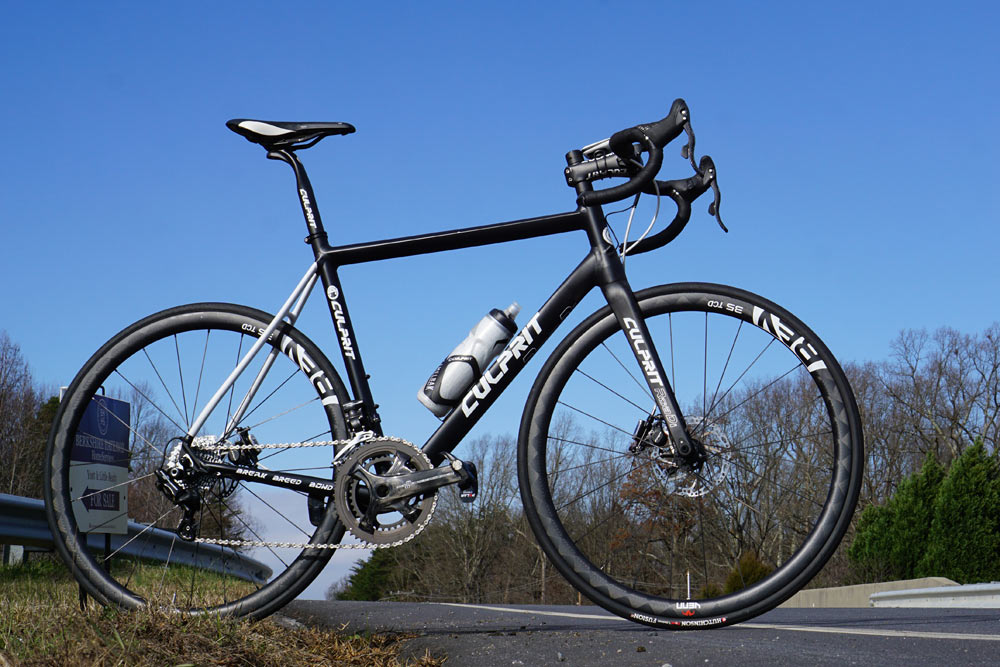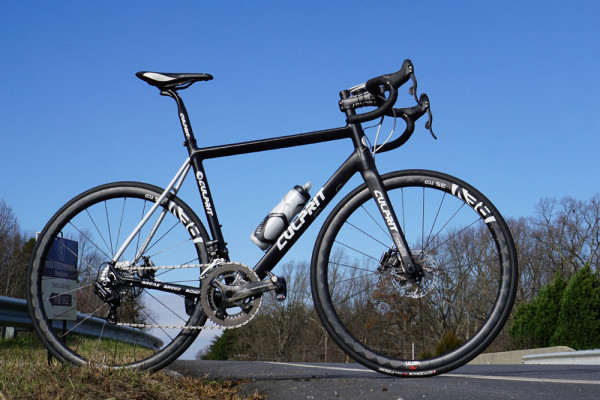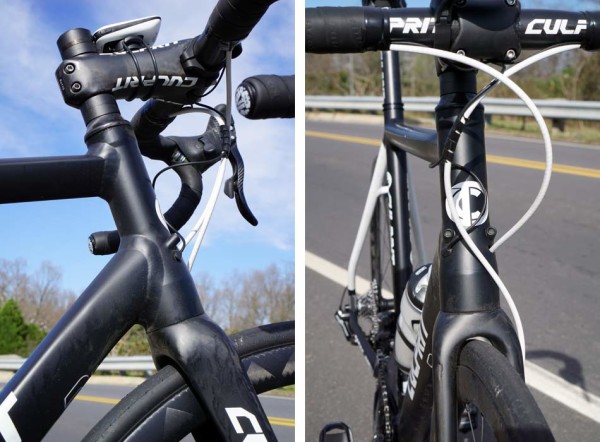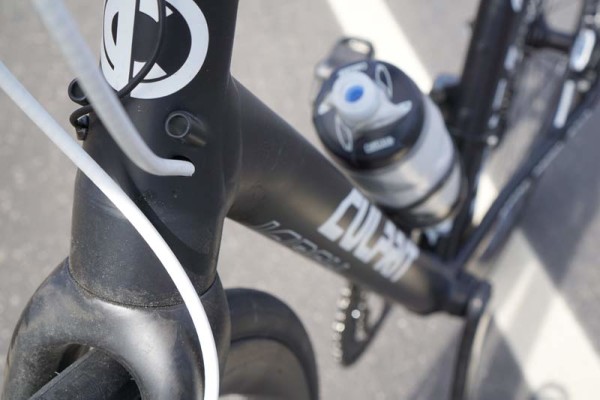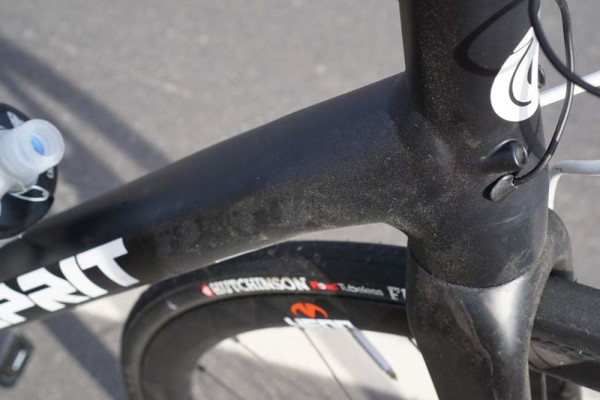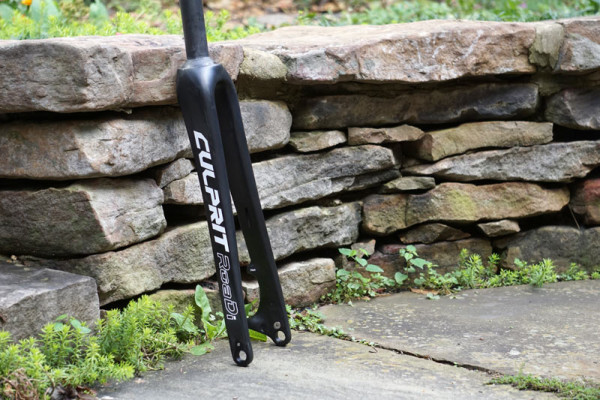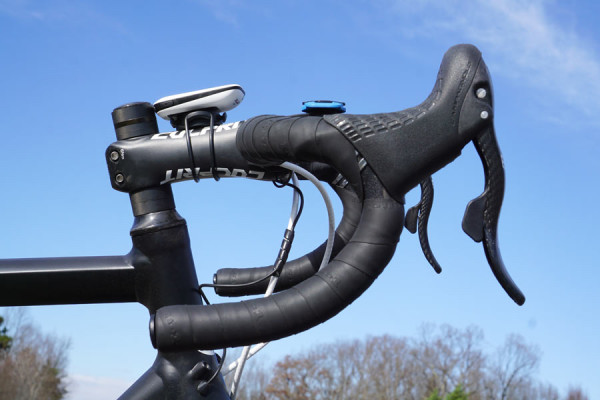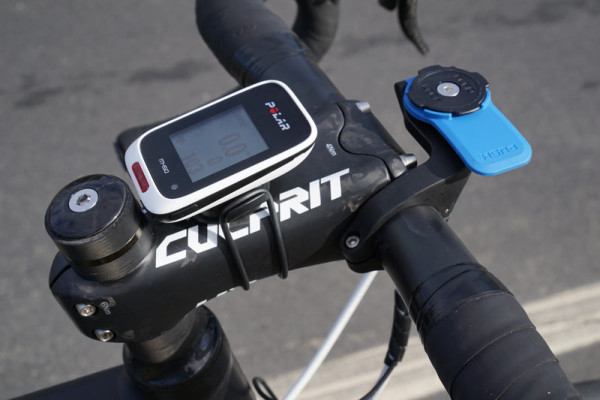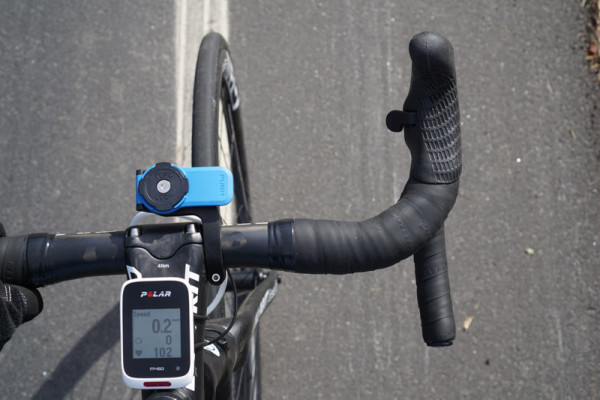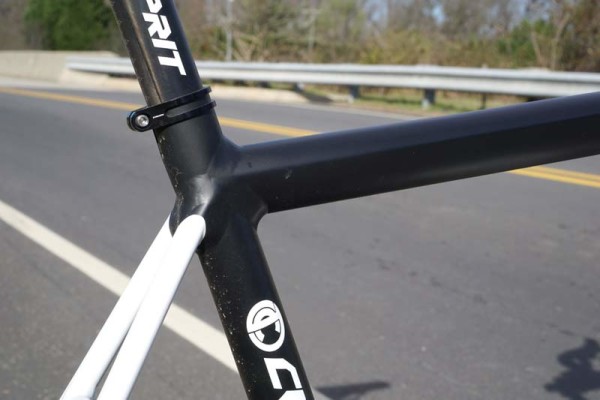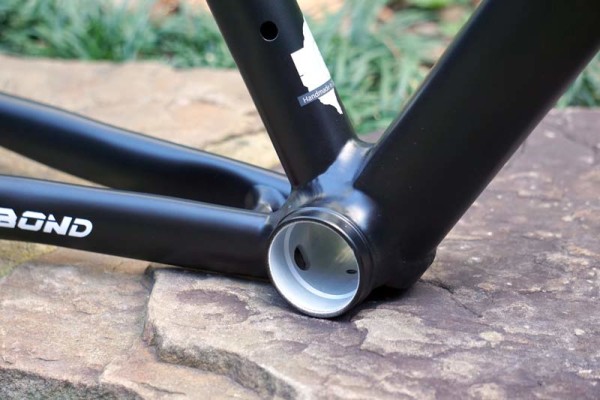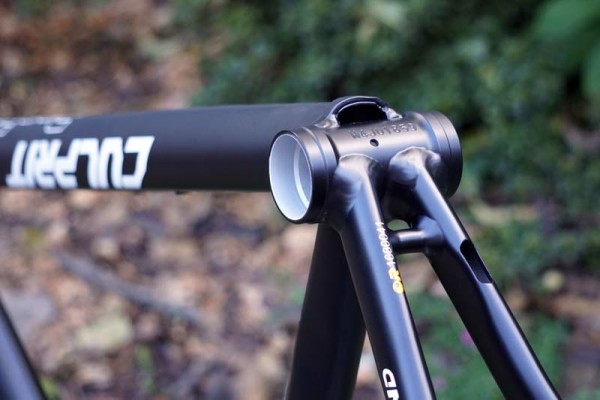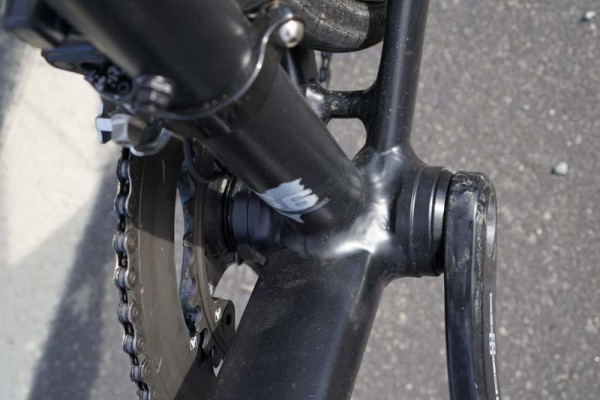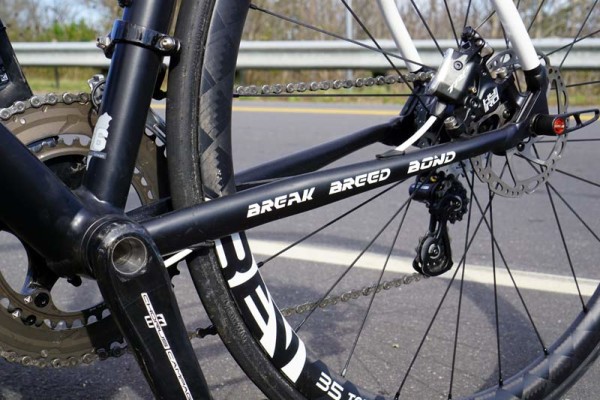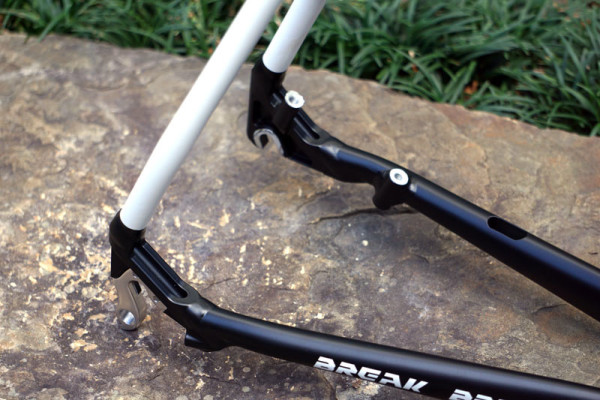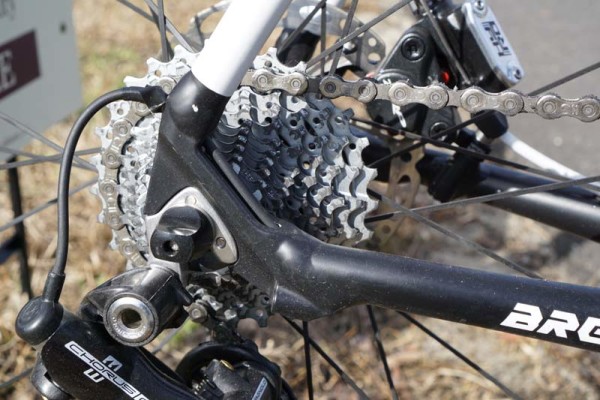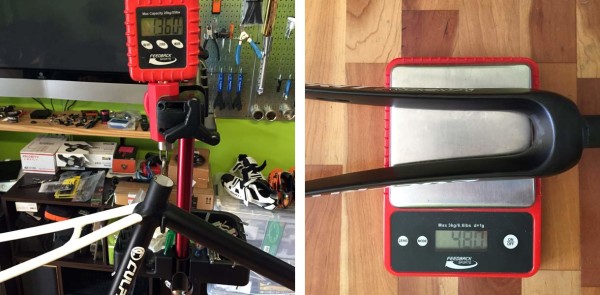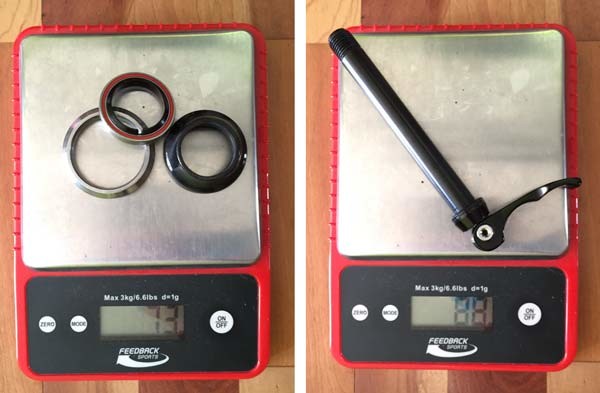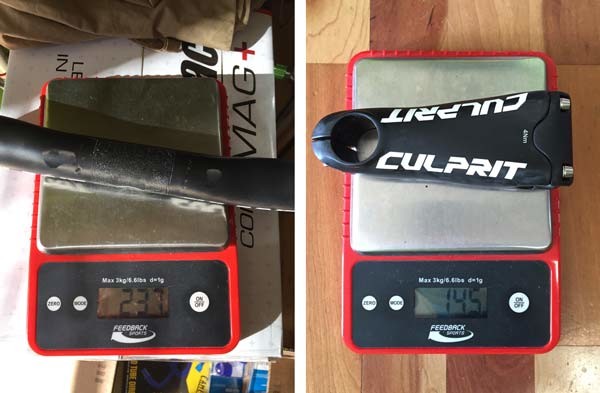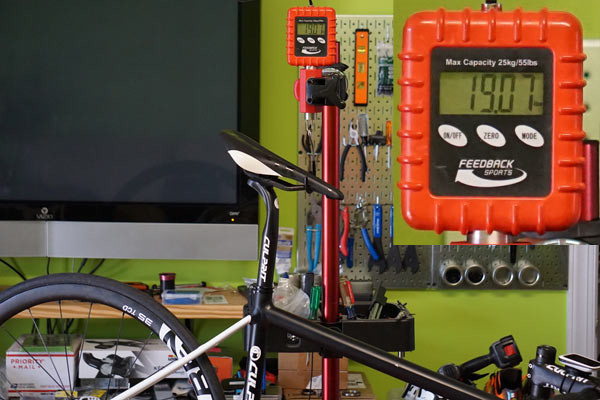While carbon gets all the glory and steel is the material of choice for the handmade set, aluminum bikes sit squarely in the realm of affordable and functional. And thanks to more modern methods of working the material, their performance is a far cry from the stiff, rattle-your-bones bikes of yesteryear.
Case in point, the Culprit RoaDi. With a frameset retail of just $1,175 with full carbon fork, seatpost, stem and handlebar, it’s a competitively priced crit bike with hydroformed, shaped 6061 tubes and smooth welds. A Shimano 105/TRP HyRD setup with Reynolds Stratus Pro wheels runs just $2,450, and Ultegra bikes with hydraulic disc brakes go for $2,695 (mechanical) and $4,175 (Di2 + Reynolds Assault SLG carbon wheels). And like their other bikes, they come with a torque tool and jersey.
But a deal is only a deal if it’s a good bike. So far, this one’s proving to be a snappy performer worthy of the Campagnolo EPS we put on it…
Starting at the front, the headtube quickly tapers into a thinner diameter and gets a slight bulge at the top to accommodate the inset bearings. Welds are massive and mostly smooth (just not Cannondale sanded smooth), and the anodization matte black paint provides uniform color on all of them.
Cables, wires and hoses are managed with four ports, two that are just holes in the frame – one for the rear brake (white cable housing) and one for electronic wires:
Mechanical shifting groups would run their housing into the ports just above the holes. For this build, they remain empty, but they’re shaped to fit a standard ferrule, so it’s not continuous housing all the way to the derailleurs.
The fork is a full carbon, two piece design that’s specific to this bike. Because of the headtube’s shape and the shift cable ports’ placement, Culprit needed to design a straight steerer to clear the internal cable housing (so it wouldn’t rub on the steerer and potentially wear it down). But, they wanted the stiffness of a tapered design.
The solution was a built-in lower crown race of full carbon. The lower bearing sits directly on the carbon crown. We put a little grease on it just to be safe, but Culprit’s founder Josh Colp says once the head assembly is pulled together snugly, there’s no room for play that could wiggle and wear down the carbon. Indeed, it sits flush and even once we tightened the top cap and secured the stem, and it’s remained tight so far.
Another clever touch is the swappable axle ends. They’re currently made for 15mm, but as 12mm gains acceptance, they’ll offer those, too. They attach with a single bolt on either side.
Clamped to the top of the fork is Culprit’s wickedly stiff full carbon stem and ergonomic handlebar. As an expat living in Taichung, Josh worked with other brands on both frame and component design and development before launching his own brand, and that experience helped shape the touch points on his bikes.
The stem is big, with a wide face to better support the handlebar. It’s one of the stiffest I’ve used, on par with Zipp’s SL Sprint. And the center section is hollow, which, along with the curvy slotted shape of the face plate, came in handy for hiding some things that we’ll reveal later.
The handlebar’s top section becomes slightly ovalized and sweeps backward for a more comfortable perch.
Wrapping the bar is Silic1 silicone gel bar tape, which Josh sent along with the frameset. The brand’s website isn’t live, so not sure about its availability, but it is nice. Soft, grippy and comfortable, and it stretched well while wrapping the bar.
Moving back is a straight round seat tube holding a 31.6mm seatpost.
The included post is Culprit’s Softer Ride design, which flattens into a rounded leaf spring at the top to help mute road bumps. While I don’t usually like this type of bolt arrangement hiding the front seat clamp bolt inside a recess, these are more easily accessed than some other brands. It just makes using a mini-tool for mid-ride adjustments a little more cumbersome. Once set, there’s been no slippage of the Fizik Antares VS Braided. This saddle’s been floating from bike to bike for a while and has me feeling warmer or cooler depending on the shorts I’m wearing. It’s more comfortable than the flatter non-VS race saddles since it has a center channel and some padding, but I’m just not quite sold on it’s shape for me. I tend to have better luck on Fizik’s MTB saddles.
Back to the bike: Down low is a pressfit BB86 bottom bracket shell. Connecting it to the headtube is a Cammtail shaped aero downtube. The shaping is subtle, but noticeable, and adds a nice visual upgrade to the frame.
Underneath is the port for the shift and rear brake lines to exit. For our build, we didn’t use the bolt-on cable guide under the BB, but it’s required for mechanical drivetrains.
We’re running 700×25 tires with plenty of clearance. 28s would likely fit just fine, but I wouldn’t go bigger than that. The fork, though, will only properly clear a 700×25.
The brake line runs out of the port and into the chainstay, popping out again just in front of the caliper. I used compressionless Yokozuna housing to ensure a crisp response from the TRP HyRD brakes. The housing is very stiff, which overpowered the rubber grommet on the underside of the chainstay…which is why you can see it popping out. The back of the grommet simply wouldn’t stay plugged into the frame.
My hunch is standard brake housing or hydraulic hose lines wouldn’t put as much pressure on it. At least it’s hidden on the bottom of the tube. The top grommet has held in place just fine. Click to enlarge.
The brake mounts are minimal, with the posts individually welded to the chainstay and dropout. The dropouts themselves are interesting, with a groove that allows distinct routing options for mechanical or electronic shifting.
Note the channel on the tops of the dropout piece. It guides a Di2 / EPS wire from inside the chainstay out the back of the frame. Di2’s smaller plugs would have an easier time fitting through, but Campy’s larger EPS plugs do fit. They also fit through the other wire holes in the frame, which is a notable feature considering some other brand’s wire ports are too small for EPS.
Mechanical drivetrains use the cable stop at the bottom, which means just two short pieces of housing are needed -one at the front, one out back- and weight is saved.
I wrapped a bit of electrical tape around the wire’s exit port to prevent wear from road vibration. It was in haste and admittedly needs to be cleaned up. Note the wire running up the dropout’s channel.
The rear dropout is standard QR with 135mm spacing and has a replaceable derailleur hanger.
ACTUAL WEIGHTS
Frame weight with hanger and water bottle bolts came in at 1,360g, and the fork with uncut steerer was 480g. That’s a decent frame weight, and the fork is just 20g more than ENVE’s disc/thru axle cyclocross fork’s claimed weight. Sure, this one’s meant for road, not ‘cross, but considering this is a two-piece design with swappable dropouts, it’s competitive.
Because of the fork’s design, it requires a specific FSA headset. Those parts weigh in at 73g and the included thru axle is 88g.
The handlebar measures 41cm center to center (43cm outside) and weighs in at 237g. The stem with all bolts is 145g. Somehow, I forgot to weigh the seatpost, but claimed weight is 200g.
The complete bike in a ready-to-ride state, including Look Keo Power pedals and the Polar M450 cycling computer, comes in at 19.07lb (8.65kg). Other parts on the bike, which will be covered in Part 2 & 3 of this project bike series include Campagnolo Chorus EPS, Venn Rev 35 TCS wheels, Hutchinson Fusion tires (tubeless), TRP HyRD brakes and the Fizik saddle.
RIDE IMPRESSIONS
Speaking only of the frame, fork and cockpit for now, it’s a winner. The shaped alloy tubes are stiff where they need to be, and the carbon cockpit (particularly the seatpost) helps smooth out the ride. The shaping and ports are well thought out, though I would like to see smoother, non-protruding cable ports on the headtube for when there’s no mechanical shift lines using them.
One peculiarity is the geometry. Normally, I ride a 58, but this one’s a size 56. But, the ETT measures 580mm, which puts it just on the short side of my preferred 585 measurement. Make the jump to their size 59 and the ETT stretches all the way to 610mm, which is why I went with the 56. But, now I see why the pros tend to ride a smaller frame. It makes for a whippy ride that’s easy to snake through a peloton or throw into a corner.
Combine that with the efficiency of a stiff frame and fork and you’ve got a crit ready frame that doesn’t brake the bank.
BONUS FROM CULPRIT: Use promo code “BIKERUMOR” on Culprit’s website and get the frameset with bonus goodies and free shipping/import fees into North America for $925 through March 5, 2016. ($625 for just basic frameset with frame, fork and seatpost. European customers must pay VAT/import fees, but also get free shipping)
